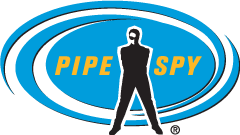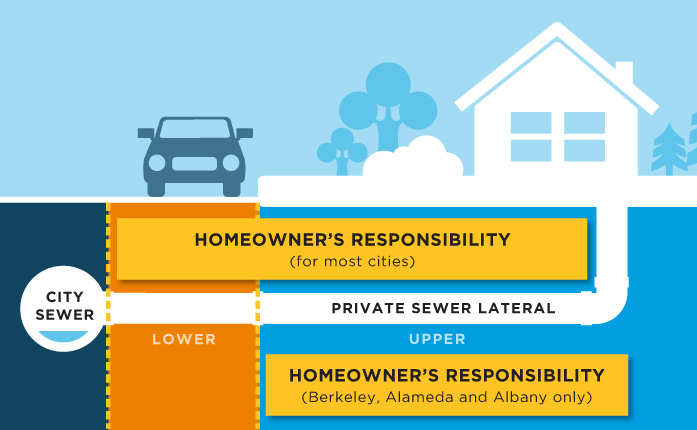Most homeowners only think about sewer lines until there’s a problem. Whenever there’s and problem with your home’s sewage system – and you live in Oakland or the East Bay – chances are you’ll be learning about the concept of a private sewer lateral (or PSL).
What is a Private Sewer Lateral?
A private sewer lateral (PSL) is the pipe that connects your home’s plumbing to the municipal sanitary sewer line, usually located under the street in front of your house. This essential pipe carries the wastewater from your home to the sewer, including everything that washes down the sink or flushes down the toilet. From there, sewage is transported to a wastewater treatment facility.
Sometimes referred to as “side sewers,” private sewer laterals consist of two primary elements:
- The upper sewer lateral – The section of pipe closer to the home, including the area from the building cleanout to the sidewalk area.
- The lower sewer lateral – The section of pipe closer to the street, including the area from the sidewalk’s curb cleanout to the public sewer main.
Who is Responsible for the Sewer Lateral?
As the term suggests, a private sewer lateral is the responsibility of the private property owner. In many cases, a homeowner is solely responsible for the upper lateral connection (in Alameda, Albany, and Berkeley, California for example). However, in San Francisco Bay Area many cities (like Oakland for instance), property owners are responsible for both the upper and lower laterals.
What Are Common Private Sewer Lateral Problems?
The condition of your private sewer lateral determines where your home’s wastewater ends up – as well as whether groundwater or rain runoff is able to enter the sewer lateral pipe.
Failure usually starts with cracks or blockages in the pipe. Common causes of sewer lateral failure:
- Natural erosion from wastewater
- Pipe corrosion, calcification, and scale buildup
- Shifting soil
- Tree root intrusion
As a sewer lateral ages, it becomes more vulnerable to fracture. The average lifetime of a private sewer lateral depends on the material used to construct the pipe. Clay pipes are the most common, but they have a limited lifespan: the old hub and spigot joints can fail, causing the pipeline to break. Today, cast iron is a more common sewer lateral material and typically has a lifespan of about 30-50 years. Another material, high-density polyethylene (HDPE), is now widely used in the industry, due to its durability, affordability, easier repair, and 100+ years of service life.
Common problems caused by a broken private sewer lateral:
- Sewer backups
- Contamination of soil and local watersheds from sewage leakage
- Excess wastewater polluting local bodies of water
- Raw sewage overflow caused by water intrusion and root growth
What Are Environmental Requirements for Private Sewer Laterals?
There are serious environmental risks associated with broken private sewer laterals. Exfiltration failures cause wastewater to flow out of the pipe and into the ground where it can threaten drinking water supplies. Inflow and infiltration failures are a more common problem however. These failures occur when rainwater or groundwater enters the pipe. In fact, this issue is so commonplace that excess water can overwhelm a community’s sewer treatment system, which causes overflows and backups that force untreated sewage into yards, streets, or nearby bodies of water (such as the San Francisco Bay).
For this reason, an Environmental Protection Agency (EPA) ordinance requires private sewer laterals to be certified. The East Bay Municipal Utility District (EBMUD) created a PSL Compliance program in 2011 that impacts our communities. Learn more about the EBMUD PSL Compliance here.
How to Fix a Broken Private Sewer Lateral?
If there are sewage issues with your home, but you’re not sure that your private sewer line is the culprit, a sewer video inspection is a good first step. This technique diagnoses the sewer line (a requirement for EBMUD PSL Certification), and reveals if your sewer line can pass a pressure test or not – before you test the line and spend additional money.
A sewer line video inspection is the only way to accurately determine the condition of your sewer line. Camera inspection can identify specific problems, including blockages that need to be removed via power snake or hydrojet. After an inspection, you will know if your sewer lateral needs to be replaced.
Contact Pipe Spy for Private Sewer Line Replacement
Once you confirm the need for sewer lateral replacement, we recommend partnering with a company that can perform trenchless sewer line repairs. The pipe-bursting technology employs a nonintrusive process in order to fix your sewer lateral with minimal inconvenience, disruption, and cost.
Pipe Spy was an early adopter and advocate of trenchless pipe bursting, and we’re proud to offer our services to customers throughout Oakland and the SF East Bay area – including video inspection (the cost of which can be credited toward a subsequent sewer lateral replacement). We also use HDPE pipe in all of our trenchless replacement projects, helping to ensure that your pipes won’t need to be replaced again during your lifetime.
Contact us to discuss your project and request more information.

